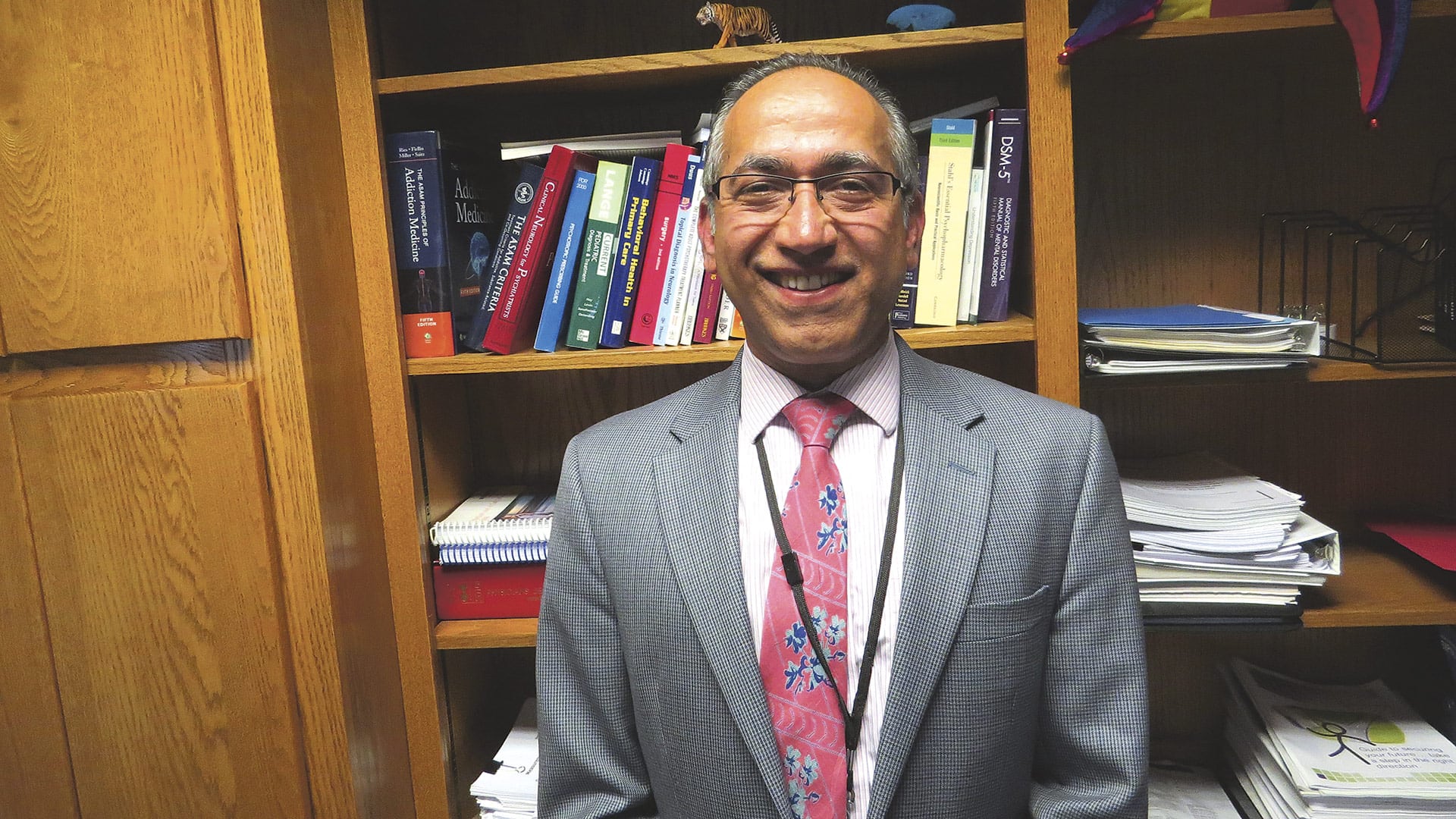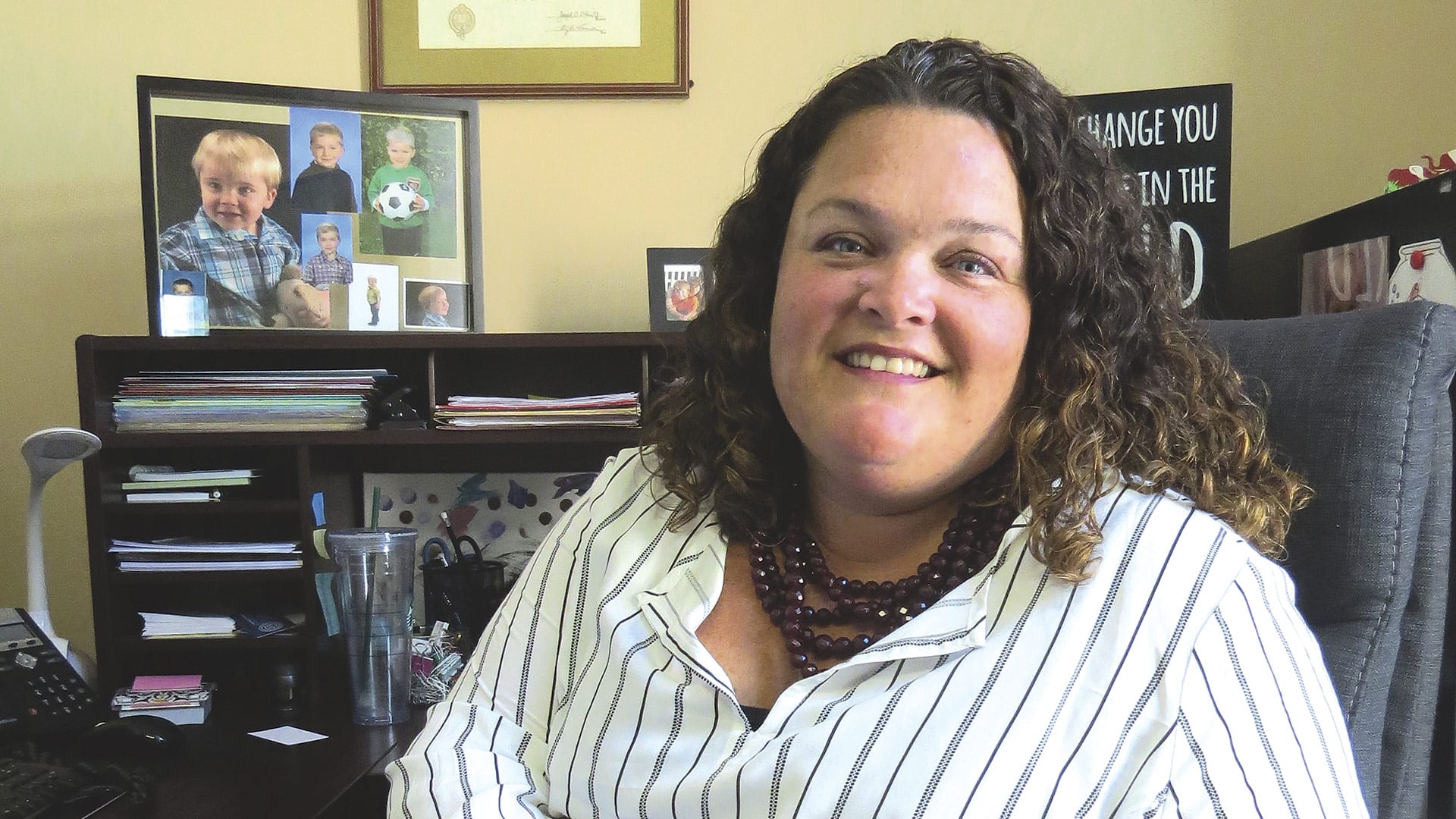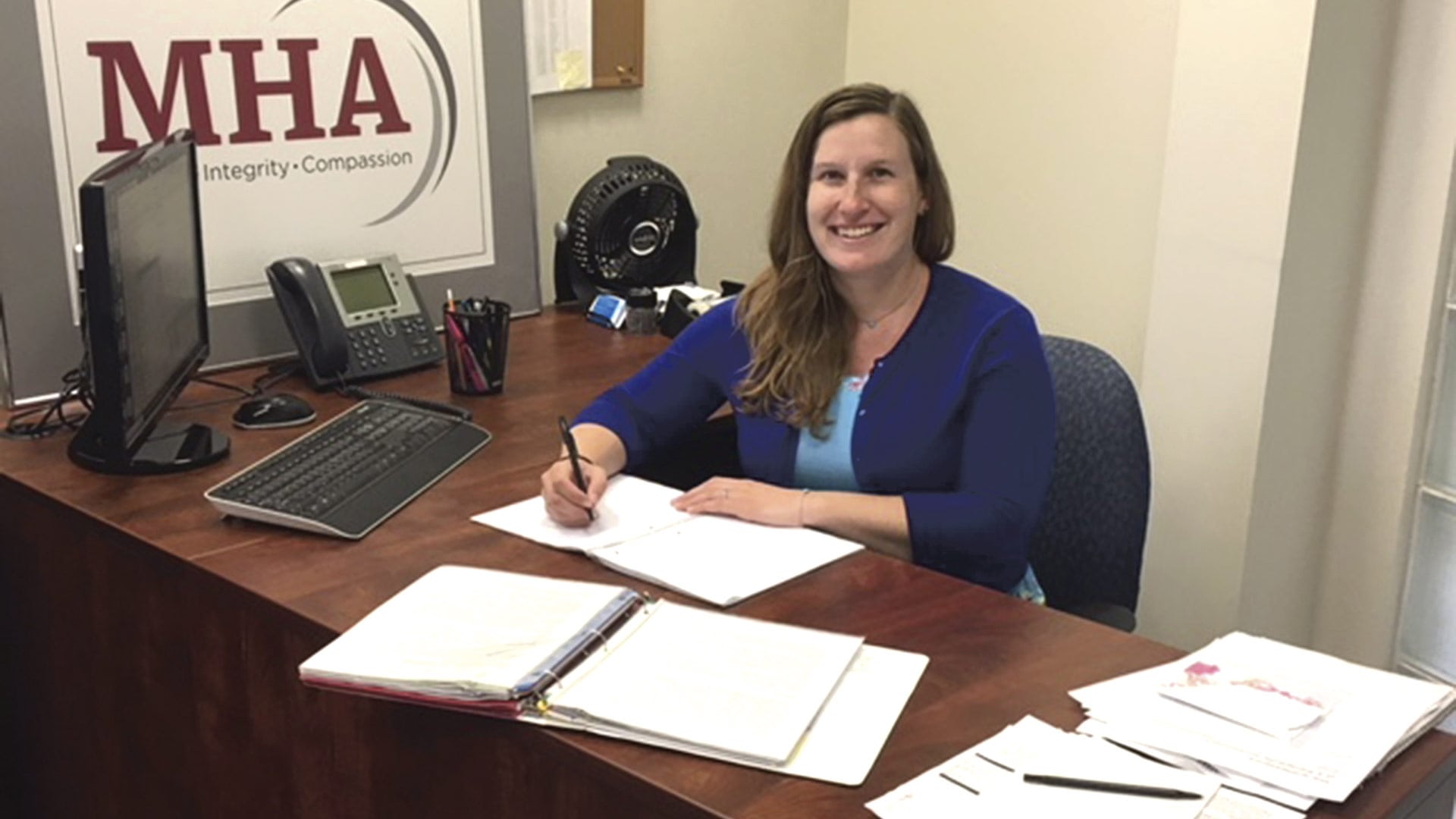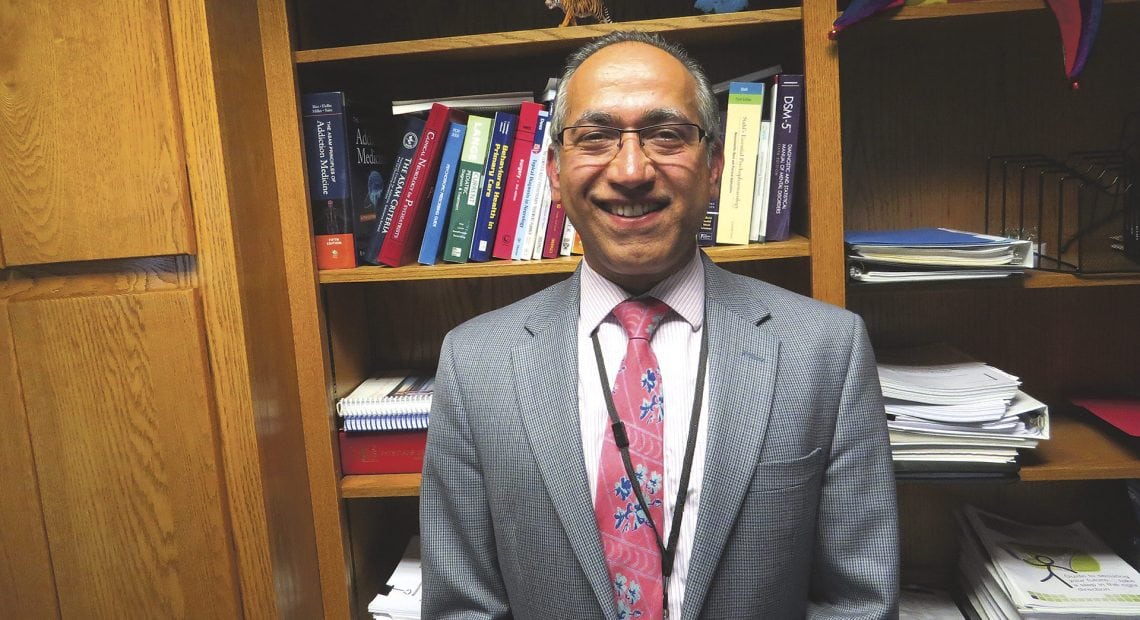A Different Kind of Health Crisis

Dr. Gaurav Chawla describes suicide as “a very unfortunate, tragic outcome of a complex set of circumstances.”
It’s a common, but certainly not universal, refrain when an individual takes his or her own life.
Friends and relatives will say they didn’t see any signs that this was coming, said Kate Hildreth-Fortin, program director, Emergency Service & Mobile Crisis Intervention with Behavioral Health Network (BHN). Or they’ll say that they could not see any apparent reason for this outcome, that the individual in question seemed outwardly happy and was enjoying life.
That’s what people said about celebrity chef Anthony Bourdain, designer Kate Spade, comedian Robin Williams, and countless others, famous and not at all famous.
“But almost always, there are warning signs, and there are reasons,” said Hildreth-Fortin, one of many who spoke with BusinessWest about a subject that is timely, immensely complicated, and a true healthcare crisis probably on the same level as the one involving opioid addiction.
“If you think about the cost society pays due to undiagnosed mental-health conditions, due to emotional crises and stressors leading to loss of function and ultimately to suicide, and how many lives are directed affected by suicide … when you think about all that, this is a public health crisis.”
Timely not just because of those celebrity suicides several months ago — although they always help bring attention to the problem — and not just because of a recent report from the Centers for Disease Control and Prevention on the growing problem.
It’s timely because the numbers continue to rise, as does the overall toll from suicide, which goes well beyond the individuals who take their own life, said Dr. Gaurav Chawla, chief medical officer at Providence Behavioral Health Hospital, part of Trinity Health Of New England, who estimated that six lives are directly impacted by each suicide.
“If you think about the cost society pays due to undiagnosed mental-health conditions, due to emotional crises and stressors leading to loss of function and ultimately to suicide,” he went on, “and how many lives are directed affected by suicide … when you think about all that, this is a public health crisis.”
Getting back to the numbers, they are eye-opening and quite alarming:
• The most recent surveys show there are 45,000 completed suicides in the U.S. every year;
• That number has steadily risen since the start of this millennium, with suicides up a total of 28% since 2000;
• Massachusetts has the third-lowest suicide rate in the nation, but the rate of suicides in the Bay State has increased 35% since 1999, well above the national average;
• Women attempt suicide at a higher rate than men, but men complete suicide at a higher rate than women;
• Firearms are used in more than 50% of suicide attempts;
• Middle-aged white men (those in their 40s to mid-50s) have the highest suicide rate, particularly when they are single, but there is another peak involving individuals over 84; and
• Among individuals ages 14-34, suicide is the second-leading cause of death after accidents.
Perhaps as disturbing and frustrating as the numbers themselves are the forces behind them. They are numerous, often difficult to see, and very difficult to combat.
But there are common denominators of a sort. For starters, suicide usually results from a combination of factors, not one in particular, said Chawla, who summed things up succinctly, noting that “there is never one reason for someone to take their life; suicide is a very unfortunate, tragic outcome of a complex set of circumstances.

In almost all cases, Kate Hildreth-Fortin says, there are warning signs with someone contemplating suicide.
“You will often see the assumption that undiagnosed mental illness or inadequately recognized or treated mental illness is the cause,” he went on. “However, that is a myth; 50% of the suicides do not have a diagnosed mental illness behind them.”
As for what is behind them, that list is obviously quite long, said Hildreth-Fortin, and could include biological and genetic factors, increasing stresses of life, relationship crises, financial and occupational stressors, poor coping styles, increased substance use, and many others.
Another common denominator is that those contemplating suicide generally feel trapped in a life that does not bring them happiness or make them fulfilled, said those we spoke with, adding that this descriptive phrase can be applied to people at every age, every income bracket, and every walk of life.
Slicing through it all, such individuals need a way out of that trap and can’t find one or are unwilling to try, said Chawla.
“Suicide is a confluence of circumstances that lead one to conclude that they’re trapped in a hopeless circumstance, sometimes without purpose, in a painful existence from which there is no other way out,” he told BusinessWest.
Meanwhile, providing a way out, especially to those suffering from behavioral-health issues (and that’s a large percentage of those who contemplate or complete suicide) is made more difficult by the persistent stigma attached to seeking help for such conditions, and then finding help in a system plagued by a shortage of resources.
These are the reasons why this is a healthcare crisis, even if the same politicians who are quick to give such a label to the opioid epidemic are mysteriously reluctant to do the same with suicide.
For this issue, BusinessWest takes a long, hard look at suicide, going beyond the numbers in a quest to explain why they continue to rise, and also looking at how area professionals are helping those who are in that aforementioned ‘trap’ and need a way out.
A Failure of the System
Hildreth-Fortin, like the others we spoke with, said that, while it is somewhat regrettable that it often takes celebrity suicides like Bourdain’s and Spade’s to bring heavy media attention to the problem of suicide, she’s happy for the attention and a chance to bring the conversations to the forefront, instead of the background, where they have been for too long.
That’s because a brighter light needs to be shone on this crisis to bring about any kind of change in the current trends. With that attention, she said, there is hope that the stigma attached to mental-health issues and seeking help for them might be diminished; hope that more resources might be brought to bear to address the crisis, as has happened with opioid addiction; hope that friends and loved ones might become aware of the warning signs — what to do when they see and hear them; and hope that those feeling trapped might be more persistent in finding a way out.
That’s a lot of hoping, but in this battle, those fighting it will take whatever help they can get, especially with regard to that stigma concerning mental health.
“Suicide is a word we use every day; it’s something we deal with every day,” said Hildreth-Fortin, whose program handles roughly 1,300 assessments a month, and 70% of these individuals, in her estimation, have suicidal thoughts. “There’s a lot we can do with prevention; we need to reduce the stigma, improve education, and treat suicide the same way we would diabetes — ‘what can we do to help someone?’”
Chawla agreed, and said the stigma attached to both suicide and mental illness and seeking help for it often contributes to a lack of understanding concerning why someone commits suicide.
That is certainly the case with celebrities such as Bourdain, Williams, and others, he went on, adding that, to most of the rest of the world, these people seem happy and content with their lives.
But it’s not the world’s perception of these individuals that matters; it’s how they view themselves, and this is true of people across all income levels and social strata.
“It’s about perceptions of who you are, how you fit in your world, and how meaningful you find your existence,” he said. “That’s what ultimately leads to or doesn’t lead to such acts.”
But while suicide is seemingly an individual act, it isn’t, and each act represents more than one person choosing that tragic outcome.
“Suicide is taken as one event by one individual, and that’s not what it is,” said Chawla. “It is the final outcome of the failure of the system. Along the way, there are many lives affected, there’s a lot of loss of function, and there is opportunity that’s missed.”
Hildreth-Fortin and others at BHN agreed, and said one huge key to perhaps reducing the number of suicides is to seize opportunities rather than miss them.
And there is quite a bit that goes into this equation, she noted, listing everything from proper training of police officers, teachers, and others to being aware of the many warning signs; from knowing what questions to ask those at risk (and asking them) to knowing how to respond to the answers to those questions.
And this means not overreacting or underreacting, and, above all, connecting people at risk with services that provide help, said Hildreth-Fortin, who, like Matthew Leone, assistant program director of the crisis unit at BHN, is trained in something called QPR, which stands for question, persuade, refer — the three basic steps in suicide prevention.
“This is training given to anyone in recognizing the risk factors, how to persuade the person to get help, and how to refer that person for help,” Leone explained, adding that, in his role, he does a lot of training in the community on how to recognize suicide.
Which brings him to those warning signs. There are many to watch for, some subtle, some most definitely not, he said.
“This is training given to anyone in recognizing the risk factors, how to persuade the person to get help, and how to refer that person for help”
They could and often do include people saying ‘goodbye’ or ‘nice to know you’ on Facebook and other platforms, individuals giving away possessions, young people suddenly drawing up a will, people losing interest in things they enjoy doing, a decrease in performance at school, and many others.
“A more overt sign might be when they start stockpiling medication or another means of following through on their plan,” Leone went on, adding that, in addition to these warning signs, which are clearly red flags, there are also risk factors.
And there are many of those, he said, starting with being a middle-age male. Others include financial distress, depression, divorce, loss of a job, being given a terminal diagnosis, and, of course, a combination of some of these.
Questions and Answers
The next part of the equation is knowing what to do when warning signs are recognized, or with someone who outwardly seems at risk, said Hildreth-Fortin.
She acknowledged that having a conversation with such an individual and asking the questions that need to be asked is awkward and often very difficult (some fear that just asking the questions can help promote a suicidal act) but it needs to be done.
“A big piece of QPR training is teaching people how to ask the question, to get someone comfortable with asking someone if they’re suicidal,” she said, adding that this training is often given to first responders and educators, but parents, spouses, friends, and employers also fall into the category of individuals who need to ask questions and need to know how to ask and also how to respond.
Questions should focus on what thoughts people are having, how often they’re having them, and whether they’ve acted on these thoughts in any way before, said Hallie-Beth Hollister, assistant program director, Community Relations for BHN, adding that the answers will generally reveal just how at-risk someone might be.

Jenni Pothier says those working with those contemplating suicide need to create a comfortable, non-judgmental, open space for dialogue to occur.
One key, she went on, is not asking leading questions that would enable the individual to give the answers the questioner might be looking for.
“Don’t say, ‘you’re not thinking of killing yourself, right?’” she said by way of example.
But, as noted, recognizing warning signs and asking the right questions are only parts of the equation. Responding to the signs and the questions to the answers is another big part, said Leone, adding that that many people balk at asking questions, or especially difficult and specific questions, because of anxiety about the answer.
“‘What do I do if the answer is yes?’” is a question that unnerves many, he went on, adding that there’s a reason for this; the response can be complex.
“We talk with people all day who mention that they’ve having suicidal thoughts,” he explained. “Some have the intent to follow through, others do not; some have vague suicidal ideation where there’s no real plan to it.”
Which is why overreaction is possible and should be avoided.
“Many times, with suicide, when someone says they’re having those thoughts, instead of starting a conversation, it ends the conversation,” he explained. “People will jump in and say, ‘we need to get them to the hospital, we need to get them help now,’ when the person is just reaching out to talk about it for help.
“And this overreaction can have a negative effect to it because then the next time the person is experiencing those thoughts, they may not say anything,” he went on, adding that the key is generating the proper response given the individual’s risk factors, warning signs, the strength of the connections in his or her life, and other factors.
Jenni Pothier, director of the Tenancy Preservation program for Springfield-based Mental Health Associates, agreed. In the course of her work, which involves helping individuals who are at risk of homelessness — a stressful situation to say the least — the subject of suicide often comes up.
“Because we know that suicide includes risk factors like poverty, experiencing potential homelessness, and a lack of access to resources, people are in crisis,” she explained. “So we’re assessing people regularly for suicide.”
And those assessments involve asking those questions mentioned above, asking them in an effective way, and responding in the appropriate manner.
“As practitioners and clinicians in the community, you need to create comfortable, non-judgmental, and open spaces for dialogue to occur,” she explained, “so people can express to you how they’re feeling without the fear of the stigma or that you’re going to instantly call 911 to get them hospitalized if they say they’re contemplating suicide or having suicidal ideations.”
Bottom Line
As she talked with BusinessWest about suicide and, more specifically, the problems many have with asking the questions that must of asked of someone at risk, Hildreth-Fortin related the story about an educator who, during a QPR training session, admitted not only that she would have difficulty asking such questions, but also that she would be upset if someone put those questions to her child.
“I had a real hard time responding to her, because it spoke so greatly to the stigma attached to this,” she said. “If your child had a stomach ache, you wouldn’t have a problem with him going to the nurse. You talk about what hurts, what kind of pain it is … we have to treat suicide the same way we would any medical symptom. We have to talk about it.”
It will take a confluence of factors and a great deal of resources to reverse the current trends on suicide, but getting people to talk about it and respond to the talk is the big first step, said Chawla, adding that only by doing so can those missed opportunities he mentioned become real opportunities to do something about a true healthcare crisis.
George O’Brien can be reached at [email protected]








